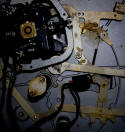-edible zone-
No.6435 Overview
Starting Line
Arrival Deconstruction
Beneath Decks
First Night's Spin
Listening to Plinths
Motor
System: The Tonearm Tweaks
Articles
Bookshelf Transit
*
Photo From Seller

Click to enlarge
The motor in a gramophone
is the source of all the energy
which we ultimately hear as sound.
Modern Gramophones & Electrical Reproducers, London, 1929
SIGNING ON
It all comes to a roll of the dice. Often enough, all you may have to go on for starters is a digi-pic that is poorly framed, out of focus and exposed under garish flash. But better that than a smooth & creamy commercial photo that conceals the flaws.
The photo is necessary in identifying the exact model of the turntable, and to some extent, the condition. The main identifier of the grease bearing version of the Garrard 301 is the knurled-brass cap that covers the grease-jet, the bulky apparatus emerging halfway up the spindle-bearing housing, perpendicular to it.
Seems like I was lucky enough to get this image from the seller, showing the undercarriage and mechanism of the 301. Where’s the grease-jet ? Help comes from a photographic direction --- the grease-jet is there, but falls into the deep black shadow next to the spindle shaft. What can really help with internet purchases is the ability to somehow get the seller’s picture into a ‘photoshop’ type program, in order to have a good, close-up look around. No matter how much of a starter program, almost all such programs allow you to run the brightness and contrast up or down, and to enlarge the image considerably.
This particular image revealed two things about this turntable in the photo program ---- first that it was in fact the well-regarded 1950’s gray greasebearing Garrard I was looking for, and second, that the seller wasn’t informed enough to feature that identifying marker.
There’s lots of analyzing and second-thinking that goes into this process, but the first real step in acquiring a Garrard is to get your hands on a Manual for the model you have in mind. There’s at least a couple available free on the internet, but they happen to be for the later version 301, the oil-bearing model. Regardless, the more info you have, the better the chances of success. These turntables ---301 and 401, grease and oil bearing---- were produced in the tens of thousands and ended up literally all over the globe. There is info on voltage and frequency that is country-specific that you’ll need to know about, and the manual is the place to start.
Other revelations from the pictures included : Medium-early serial, no. 6435, a 60-hz motordrive-pulley, and all parts appeared to be original, with the common enough exception of the plastic AC ‘zipcord’ which would generally be a replacement anyway. No rehab or repaint seemed apparent. I guess I regard a thick undisturbed dust-coat as indicative that the seller hasn’t done any surgery or experimentation. Likewise the appearance of bolts, nuts and fasteners --- even a 50 year old unit should not show stripped screwheads or buggered hexes.
On the Upper Deck, there were no signs of Radio-Station use, which are usually of two kinds. Look for the well worn paint on the On-Off corner of the deck, where the Dj rested his hand or cuff preceding a million cross-cues between Table One and Table Two; no normal listener inflicts that kind of constant wear. Look also for the arc-shaped scratch along the line of the stylus travel between arm-rest and platter. Radio station wear looks kind of reminiscent of the condition of an old public-school desk, or a public phone-booth…. Not a good candidate for restoration, usually, though you can't rule it out. A radio station 301 would have benefitted from regular maintenance and lubrications, after all.
For my 301, on the minus side, the transit-bracket that stabilzes the motor in shipping was missing, and paint was missing on the motor’s bottom cover, both fairly common, but only one can be addressed. With a knowledgable seller, you can explain finding a couple of suitable bolts and fastening the motor to the motor’s shockmount bracket. And even with a reasonable first-time seller, you can talk them thru immobilizing and wedging the motor and platter, minding that the pitch control is at maximum (ie disengaged) and the on-off switch is soundly in the Off detent.
And oh yes, the Dust-Bug mark. There was an idiotic invention years ago that incorporated a kind of rolling velvet carpet on a tonearm-like device. Which when removed also tended to remove the paint from a good two-thirds of the 301’s in circulation. I guess it’s kind of like a birthmark, since no two are in exactly the same place, and also an assurance of genuine authenticity, since no 301 counterfeiter could bring himself to desecrate an otherwise plausible-looking finish this way. That would be too close … to genius.

Seventy-eight RPM Postcard